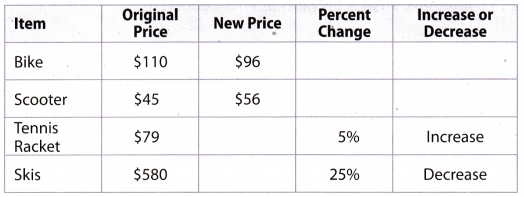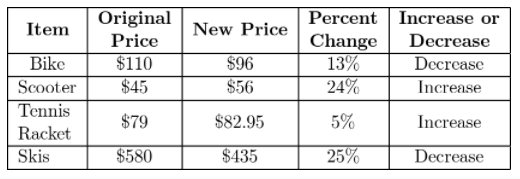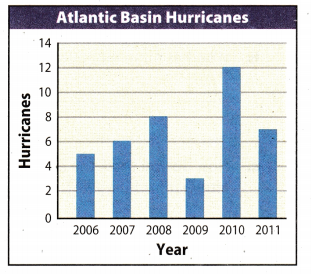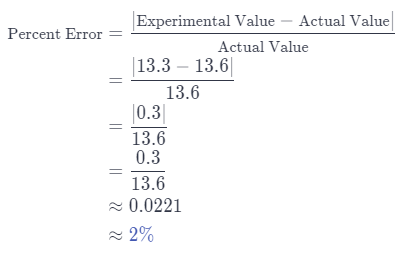Refer to our Texas Go Math Grade 7 Answer Key Pdf to score good marks in the exams. Test yourself by practicing the problems from Texas Go Math Grade 7 Lesson 3.2 Answer Key Percent Increase and Decrease.
Texas Go Math Grade 7 Lesson 3.2 Answer Key Percent Increase and Decrease
Example 1
Amber got a raise, and her hourly wage increased from $8 to $9.50. What is the percent increase?
Step 1: Find the amount of change.
Amount of Change = Greater Value – Lesser Value
= 9.50 – 8.00 Substitute values
= 1.50 Subtract
Step 2: Find the percent increase. Round to the nearest percent.
Percent Change = \(\frac{\text { Amount of Change }}{\text { Original Amount }}\)
= \(\frac{1.50}{8.00}\) Substitute values
= 0.1875 Divide.
≈ 19% Write as a percent and round.
Reflect
Question 1.
What does a 100% increase mean?
Answer:
100% increase means that a value has doubled.
Your Turn
Question 2.
The price of a pair of shoes increases from $52 to $64. What is the percent increase to the nearest percent?
Answer:
Find the amount of change.
Amount of Change = Greater Value – Lesser value
= 64 – 52
= 12
Find the percent increase. Round to the nearest percent
Percent Change = \(\frac{\text { Amount of Change }}{\text { Original Amount }}\)
= \(\frac{12}{52}\)
= 0.2308
= 23%
Example 2
David moved from a house that is 89 miles away from his workplace to a house that is 51 miles away from his workplace. What is the percent decrease in the distance from his home to his workplace?
Step 1: Find the amount of change.
Amount of Change = Greater Value – Lesser Value
= 89 – 51 Substitute values.
= 38 Subtract.
Step 2: Find the percent decrease. Round to the nearest percent.
Percent Change = \(\frac{\text { Amount of Change }}{\text { Original Amount }}\)
= \(\frac{38}{89}\) Substitute values
≈ 0.427 Divide.
≈ 19% Write as a percent and round.
Reflect
Question 3.
Critique Reasoning David considered moving even closer to his workplace. He claims that if he had done so, the percent of decrease would have been more than 100%. Is David correct? Explain your reasoning.
Answer:
David is not correct. Distance of workplace is an absolute value If the percent of decrease would be more than 100%, that would mean the distance would be negative. That does not make any sense since the distance is an absolute value which is always positive.
Your Turn
Question 4.
The number of students in a chess club decreased from 18 to 12. What is the percent decrease? Round to the nearest percent. ___________
Answer:
Find the amount of change.
Amount of Change = Greater Value – Lesser value
= 18 – 12
= 6
Find the percent decrease. Round to the nearest percent
Percent Change = \(\frac{\text { Amount of Change }}{\text { Original Amount }}\)
= \(\frac{6}{18}\)
= 0.3
= 33%
Question 5.
Officer Brimberry wrote 16 tickets for traffic violations last week, but only 10 tickets this week. What is the percent decrease? ______________
Answer:
Find the amount of change.
Amount of Change = Greater Value – Lesser value
= 16 – 10
= 6
Find the percent decrease. Round to the nearest percent
Percent Change = \(\frac{\text { Amount of Change }}{\text { Original Amount }}\)
= \(\frac{6}{16}\)
= 0.375
= 38%
Reflect
Question 6.
Why will the percent of change always be represented by a positive number?
Answer:
Because it is just the measure of change. If there is positive change, you say there is increase of certain percentage and if there is negative change, you say there is fall by certain percentage. For example: If your weight increases by 10 kilos and ¡f you are 40 kilos now, then you say your weight has increased by 25% which is positive obviously. If your weight decreases by 10 kilos, then you say your weight has decreased or reduced by 25% rather than saying your weight has been changed by -10%. So it is just the matter using the words and numbers in appropriate manner.
Question 7.
Draw Conclusions If an amount of $100 in a savings account increases by 10%, then increases by 10% again, is that the same as increasing by 20%? Explain.
Answer:
It is not the same value. First increase was by 10% of 100. that is $10.
Second increase was 10% of $100+$10 = $110. that is $11. $110 + $11 = $121
A straight increase by 20% is $20. $100 + $20 = $120
$121 ≠ $120
Your Turn
A TV has an original price of $499. Find the new price after the given percent of change.
Question 8.
10% increase ___________
Answer:
First. multiply TV’s price with the percentage expressed in decimals.
499 × 10% = 499 × 0.1
= $19.9
Now. since it was an increase, add the obtained value to the TV’s price.
$499 + $49.9 = $548.9
New price of the TV is $548.9.
Question 9.
30% decrease _____________
Answer:
First, multiply TV’s price with the percentage expressed in decimals.
499 × 30% = 199 × 0.3
= $149.7
Now, since it was an decrease, subtract the obtained value from the TV’s price.
$499 – $149.7 = $319.3
New price of the TV is $349.3.
Texas Go Math Grade 7 Lesson 3.2 Guided Practice Answer Key
Find each percent increase. Round to the nearest percent. (Example 1)
Question 1.
From $5 to $8 _______________________
Answer:
Find the amount of change.
Amount of Change = Greater Value – Lesser value
= 8 – 5
= 3
Find the percent increase. Round to the nearest percent
Percent Change = \(\frac{\text { Amount of Change }}{\text { Original Amount }}\)
= \(\frac{3}{5}\)
= 0.6
= 60%
Question 2.
From 20 students to 30 students _____________
Answer:
Find the amount of change.
Amount of Change = Greater Value – Lesser value
= 30 – 20
= 10
Find the percent increase. Round to the nearest percent
Percent Change = \(\frac{\text { Amount of Change }}{\text { Original Amount }}\)
= \(\frac{10}{20}\)
= 0.5
= 50%
Question 3.
From 86 books to 150 books ______________.
Answer:
Find the amount of change.
Amount of Change = Greater Value – Lesser value
= 150 – 86
= 64
Find the percent increase. Round to the nearest percent
Percent Change = \(\frac{\text { Amount of Change }}{\text { Original Amount }}\)
= \(\frac{64}{86}\)
= 0.7441
= 74%
Question 4.
From $3.49 to $3.89 _______________
Answer:
Find the amount of change.
Amount of Change = Greater Value – Lesser value
= 3.89 – 3.49
= 0.4
Find the percent increase. Round to the nearest percent
Percent Change = \(\frac{\text { Amount of Change }}{\text { Original Amount }}\)
= \(\frac{0.4}{3.49}\)
= 0.1146
= 11%
Question 5.
From 13 friends to 14 friends _______________
Answer:
Find the amount of change.
Amount of Change = Greater Value – Lesser value
= 14 – 13
= 1
Find the percent increase. Round to the nearest percent
Percent Change = \(\frac{\text { Amount of Change }}{\text { Original Amount }}\)
= \(\frac{1}{13}\)
= 0.0769
= 8%
Question 6.
From 5 miles to 16 miles ________________
Answer:
Find the amount of change.
Amount of Change = Greater Value – Lesser value
= 16 – 5
= 11
Find the percent increase. Round to the nearest percent
Percent Change = \(\frac{\text { Amount of Change }}{\text { Original Amount }}\)
= \(\frac{11}{5}\)
= 2.2
= 220%
Question 7.
Nathan usually drinks 36 ounces of water per day. He read that he should drink 64 ounces of water per day. If he starts drinking 64 ounces, what is the percent increase? Round to the nearest percent. (Example 1)
Answer:
Find the amount of change.
Amount of Change = Greater Value – Lesser value
= 64 – 36
= 28
Find the percent increase. Round to the nearest percent
Percent Change = \(\frac{\text { Amount of Change }}{\text { Original Amount }}\)
= \(\frac{28}{36}\)
= 0.7
= 78%
Find each percent decrease. Round to the nearest percent. (Example 2)
Question 8.
From $80 to $64 ______________
Answer:
Find the amount of change.
Amount of Change = Greater Value – Lesser value
= 80 – 64
= 16
Find the percent decrease. Round to the nearest percent
Percent Change = \(\frac{\text { Amount of Change }}{\text { Original Amount }}\)
= \(\frac{16}{80}\)
= 0.2
= 20%
Question 9.
From 95 °F to 68 °F ________________
Answer:
Find the amount of change.
Amount of Change = Greater Value – Lesser value
= 95 – 68
= 27
Find the percent decrease. Round to the nearest percent
Percent Change = \(\frac{\text { Amount of Change }}{\text { Original Amount }}\)
= \(\frac{27}{95}\)
= 0.2842
= 28%
Question 10.
From 90 points to 45 points ____________
Answer:
Find the amount of change.
Amount of Change = Greater Value – Lesser value
= 90 – 45
= 45
Find the percent decrease. Round to the nearest percent
Percent Change = \(\frac{\text { Amount of Change }}{\text { Original Amount }}\)
= \(\frac{45}{90}\)
= 0.5
= 50%
Question 11.
From 145 pounds to 132 pounds ______________
Answer:
Find the amount of change.
Amount of Change = Greater Value – Lesser value
= 145 – 132
= 13
Find the percent decrease. Round to the nearest percent
Percent Change = \(\frac{\text { Amount of Change }}{\text { Original Amount }}\)
= \(\frac{13}{145}\)
= 0.0897
= 9%
Question 12.
From 64 photos to 21 photos _____________
Answer:
Find the amount of change.
Amount of Change = Greater Value – Lesser value
= 64 – 21
= 43
Find the percent decrease. Round to the nearest percent
Percent Change = \(\frac{\text { Amount of Change }}{\text { Original Amount }}\)
= \(\frac{43}{64}\)
= 0.6719
= 67%
Question 13.
From 16 bagels to 0 bagels _______________
Answer:
Find the amount of change.
Amount of Change = Greater Value – Lesser value
= 16 – 0
= 16
Find the percent decrease. Round to the nearest percent
Percent Change = \(\frac{\text { Amount of Change }}{\text { Original Amount }}\)
= \(\frac{16}{16}\)
= 1
= 100%
Question 14.
Over the summer, Jackie played video games 3 hours per day. When school began in the fall, she was only allowed to play video games for half an hour per day. What is the percent decrease? Round to the nearest percent. (Example 2)
Answer:
Find the amount of change.
Amount of Change = Greater Value – Lesser value
= 3 – 0.5
= 2.5
Find the percent decrease. Round to the nearest percent
Percent Change = \(\frac{\text { Amount of Change }}{\text { Original Amount }}\)
= \(\frac{2.5}{3}\)
= 0.83
= 83%
Find the new amount given the original amount and the percent of change. (Example 3)
Question 15.
$9; 10% increase ____________________
Answer:
Find the amount of change.
$9 × 10% = $9 × 0.1
= $0.9
Now, since it was an increase, add the obtained value to the starting value.
$9 + $0.9 = $9.9
Question 16.
48 cookies; 25% decrease _______________
Answer:
Find the amount of change.
48 × 25% = 48 × 0.25
=12
Now, since it was a decrease, subtract the obtained value from the starting value.
48 – 12 = 36 cookies
Question 17.
340 pages; 20% decrease _____________
Answer:
Find the amount of change.
340 × 20% = 340 × 0.2
= 68
Now, since it was a decrease, subtract the obtained value from the starting value.
340 – 68 = 272 pages
Question 18.
28 members; 50% increase ________________
Answer:
Find the amount of change.
28 × 50% = 28 × 0.5
= 14
Now, since it was an increase, add the obtained value to the starting value
28 + 14 = 42 members
Question 19.
$29,000; 4% decrease ________________
Answer:
Find the amount of change.
$29000 × 4% = $29000 × 0.04
= $1160
Now, since it was a decrease, subtract the obtained value from the starting value
$29000 – $1160 = $27840
Question 20.
810 songs; 130% increase _________________
Answer:
Find the amount of change.
810 × 130% = 810 × 1.3
= 1053
Now, since it was an increase, add the obtained value to the starting value.
810 + 1053 = 1863 songs
Question 21.
Adam currently runs about 20 miles per week, and he wants to increase his weekly mileage by 30%. How many miles will Adam run per week? (Example 3)
Answer:
Find the amount of change.
20 × 30% = 20 × 0.3
= 6
Now, since it was an increase, add the obtained value to the starting value.
20 + 6 = 26 miles
Adam will have to run 26 miles per week.
Essential Question Check-In
Question 22.
What process do you use to find the percent change of a quantity?
Answer:
First, we find the amount of change by subtracting lesser value from the greater value.
Amount of Change = Greater Value – Lesser Value
Then, we divide the amount of change by the original amount
Percent Change = \(\frac{\text { Amount of Change }}{\text { Original Amount }}\)
Texas Go Math Grade 7 Lesson 3.2 Independent Practice Answer Key
Question 23.
Complete the table.

Answer:

Bike:
Find the amount of change.
Amount of Change = Greater Value – Lesser value
= 110 – 96
= 14
Find the percent decrease (Original Price greater than New Price) Round to the nearest percent.
Percent Change = \(\frac{\text { Amount of Change }}{\text { Original Amount }}\)
= \(\frac{14}{110}\)
≈ 0.1273
≈ 13%
Scooter:
Find the amount of change.
Amount of Change = Greater Value – Lesser value
= 56 – 45
= 11
Find the percent increase (Original Price lesser than New Price). Round to the nearest percent.
Percent Change = \(\frac{\text { Amount of Change }}{\text { Original Amount }}\)
= \(\frac{11}{45}\)
= 0.24
= 24%
Tennis Racket:
Find the amount of change
79 × 5% = 75 × 0.05
= 3.95
Now, since it was an increase, add the obtained value to the starting value
$79 + $3.95 = $82.95
Skis:
Find the amount of change.
580 × 25% = 580 × 0.25
= 145
Now, since it was a decrease, subtract the obtained value from the starting value.
$580 – $145 = $435
Question 24.
Multiple Representations The bar graph shows the number of hurricanes in the Atlantic Basin from 2006-2011.

a. Find the amount of change and the percent of decrease in the number of hurricanes from 2008 to 2009 and from 2010 to 2011. Compare the amounts of change and percents of decrease.
Answer:
2008.- 2009.
2008. – 8 hurricanes
2009. – 3 hurricanes
It is an obvious decrease.
Find the amount of change.
Amount of Change = Greater Value – Lesser value
= 8 – 3
= 5
Find the percent decrease. Round to the nearest percent.
Percent Change = \(\frac{\text { Amount of Change }}{\text { Original Amount }}\)
= \(\frac{5}{8}\)
= 0.625
≈ 63%
2010.- 2011.
2010. – 12 hurricanes
2011. – 7 hurricanes
It is, again, an obvious decrease.
Find the amount of change.
Amount of Change = Greater Value – Lesser value
= 12 – 7
= 5
Find the percent decrease. Round to the nearest percent.
Percent Change = \(\frac{\text { Amount of Change }}{\text { Original Amount }}\)
= \(\frac{5}{12}\)
= 0.416
≈ 42%
Amounts of change are the same, but the first percent change is greater because the original amount is lesser.
b. Between which two years was the percent of change the greatest? What was the percent of change during that period?
Answer:
We conclude that the greatest percentage change is between 2008. – 2009. The percent of change during that period was 63%
Question 25.
Represent Real-World Problems Cheese sticks that were previously priced at “5 for $1” are now “4 for $1”.
a. Find the percent decrease in the number of cheese sticks you can buy for $1.
Answer:
Find the amount of change.
Amount of Change = Greater Value – Lesser value
= 5 – 4
= 1
Find the percent decrease. Round to the nearest percent.
Percent Change = \(\frac{\text { Amount of Change }}{\text { Original Amount }}\)
= \(\frac{1}{5}\)
= 0.2
20%
You can now buy 20% less cheese sticks for $1 than before.
b. Find the percent increase in the price per cheese stick.
Answer:
Price before = $1 ÷ 5 = $0.2
Price now = $1 ÷ 4 = $0.25
Find the amount of change.
Amount of Change = Greater Value — Lesser value
= 2.5 – 2
= 0.5
Find the percent increase. Round to the nearest percent.
Percent Change = \(\frac{\text { Amount of Change }}{\text { Original Amount }}\)
= \(\frac{0.5}{2}\)
= 0.25
25%
Question 26.
Percent error calculations are used to determine how close to the true values, or how accurate, experimental values really are. The formula is similar to finding percent of change.
Percent Error = \(\frac{\mid \text { Experimental Value }-\text { Actual Value| }}{\text { Actual Value }}\) × 100%
In chemistry class, Charlie records the volume of a liquid as 13.3 milliliters. The actual volume is 1 3.6 milliliters. What s his percent error? Round to the nearest percent. __________________________________
Answer:
Experimental Value = 13.3 milimeters
Actual Value = 13.6 milimeters
Use the given formula to calculate Percent Error

H.O.T. Focus On Higher Order Thinking
Question 27.
Look for a Pattern Leroi and Sylvia both put $100 in a savings account. Leroi decides he will put in an additional $10 each week. Sylvia decides to put in an additional 10% of the amount in the account each week.
a. Who has more money after the first additional deposit? Explain.
Answer:
Lerol put $10. now she has $100 + $10 = $100.
Sylvia put 10% × $100 = $10, now she has $100 + $10 = $110.
Conclusion: They both have the same amount of money after the first additional deposit.
b. Who has more money after the second additional deposit? Explain.
Answer:
Since Lerol adds again $10. and Sylvia 10%. it is obvious that Sylvia now has more money. because she adds 10% × $100 = $11.
$11 > $10
c. How do you think the amounts in the two accounts will compare after a month? A year?
Answer:
Obviously, Sylvia will have more money as the time progresses, because she keeps adding a greater amount with each month. while Lerol always adds the same amount of money.
Question 28.
Critical Thinking Suppose an amount increases by 100%, then decreases by 100%. Find the final amount would the situation change if the original increase was 150%? Explain your reasoning.
Answer:
Let x be the amount of money.
First, increase its value by 100%.
x + 100% × x = x + x = 2x
Now, decrease obtained value by 100%.
2x – 100% × 2x = 2x – 2x = 0
The final, amount is 0.
Now, calculate if the original increase would be 150% followed by the same decrease.
x + 150% × x = x + 1.5x = 2.5x
2.5x – 100% × 2.5x = 2.5x – 2.5x = 0
We can conclude that no matter how many percent the amount increases, if it decreases by 100% after, it will equal 0.
Question 29.
Look for a Pattern Ariel deposited $100 into a bank account. Each Friday she will withdraw 10% of the money in the account to spend. Ariel thinks her account will be empty after 10 withdrawals. Do you agree? Explain.
Answer:
That is not correct. Actually, that way she would never empty her bank account.
First month she would withdraw 10% × $100 = $10
She n0w has $100 – $10 = $90 on her account.
Next month she would withdraw 10% × $90 = $9
She now has $90 – $9 = $81 on her account.
The amount on her account would decrease more slowly with each withdrawal but would level reach $0.